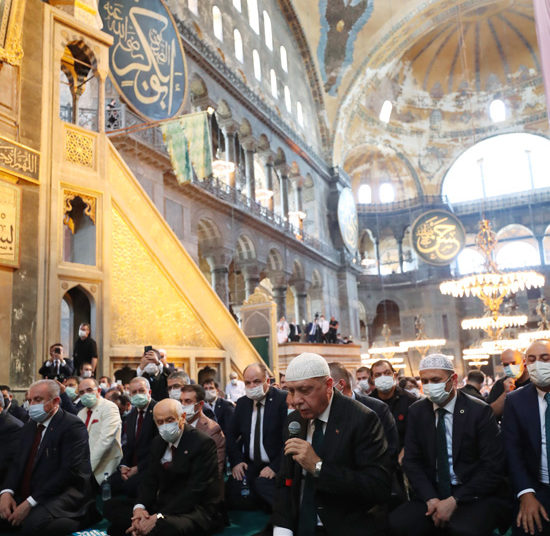Nordic Monitor
The conversion of Hagia Sophia back into a mosque by President Recep Tayyip Erdoğan has sparked a debate on the re-establishment of the caliphate, which was abolished by the founder of Turkey, Mustafa Kemal Atatürk, in 1924, among ruling Justice and Development Party (AKP) supporters.
Erdoğan’s triumphalist action was welcomed by traditional nationalist and religious segments of Turkish society. His supporters, who are thrilled with the decision as well as with the first Friday prayers, have launched a discussion on the reconstitution of the caliphate as a next step.
Gerçek Hayat, an Islamist magazine owned by the Yeni Safak daily, called for the revival of the caliphate in Turkey in its July 27 issue. “Hagia Sophia and Turkey are now free (“Artık Ayasofya ve Türkiye hür”). If not now, when? If not you, who? Get together for Caliphate (“Hilafet için toparlanın”),” the cover reads.
Moreover, Turkey’s Yeni Şafak daily, a mouthpiece for the Erdoğan regime owned by the Albayrak group, reported, with reference to a social media message by author Ahmet Anapalı, that a 2,000-square-meter turquoise wool carpet, specially woven for Hagia Sophia, was donated by President Erdoğan. According to the report, Anapalı described Erdoğan as “a person called caliph by the Islamic Ummah.”

In a speech following a cabinet meeting on July 27, President Erdoğan signaled further steps after the Hagia Sophia reconversion. “Yes, by acting in accordance with Allah’s command and promise, we will turn to the next task after finishing the job at hand. We brought Hagia Sophia, our dream of 86 years, together with the Qur’an, prayer and its congregation again. Now is the time to turn to other jobs we will do for our nation and for all of humanity,” he said.
Abdurrahman Dilipak, a journalist who has the president’s ear, also shared the cover of Gerçek Hayat on his social media account. Speaking to the Turkish government’s anti-Semitic and anti-Western mouthpiece Akit TV on July 8, Dilipak stated that “the caliphate rule is an authority given to President Erdoğan by the law because it [the law] is embedded within the republic’s spirit. Therefore, we have properties [from the caliphate era] in 110 countries. In Malaysia we have vast lands, buildings, many structures, mosques. They are not only located in Greece, Bulgaria, Bosnia, Azerbaijan and the Caucasus. They do not have any owner. I said [to President Erdoğan] that you built so many rooms in Beştepe [Erdoğan’s 1,150-room palace], yet three out of four of these rooms are empty. You should put international representatives from religious groups of each Muslim nation in these rooms. This is Turkey’s commonwealth. … Let’s get representatives from each Islamic nation, and they will represent these countries in Turkey.”
According to pro-government analysts, the caliphate will provide the Turkish president with an opportunity to exert control over Muslims around the world.

On July 24 President Erdoğan attended the first Friday prayer, an official ceremony, at Hagia Sophia following its re-conversion into a mosque, a crowning moment for him after 18 years at the helm of Turkish politics. “This is Hagia Sophia breaking away from its chains of captivity. It was the greatest dream of our youth,” Erdoğan said before the reopening. “It was the yearning of our people, and now it has been accomplished.”
About 1,000 people were allowed in through security checkpoints, while others laid out prayer rugs outside. The Turkish president and an entourage of senior ministers arrived for the service in the heart of Istanbul’s historic district, and then four muezzin recited the call to prayer from each of the four minarets.
Erdoğan began the service with a recital from the Qur’an, and later Ali Erbaş, head of the state religious affairs agency, the Diyanet, continued the formal prayers for hundreds of specially invited attendees and delivered the Friday sermon (khutbah) inside the Hagia Sophia, holding a sword, an Ottoman tradition symbolizing conquest.
“The reopening of Hagia Sophia … is the return of a sacred place, which had embraced believers for five centuries, to its original function,” Erbaş said. Moreover, Erbaş implicitly criticized Atatürk by referencing Sultan Mehmet II’s declaration that any person who used the site for purposes other than as a mosque would be damned.

Following Friday prayers, President Erdoğan also made a short statement before heading to the tomb of Sultan Mehmed II, who took Istanbul from the Byzantines in 1453.
“After the judiciary saw the truth, this place returned to what it originally was. Now it will serve all believers as a mosque again. It is also a place that people from all religions can come and visit as a cultural heritage of humanity. Now, let’s visit the grave of Sultan Mehmed the Conqueror, the real owner,” he said, citing official figures that there were more than 350,000 people present around the building.

President Erdoğan ordered the conversion of the country’s historic Hagia Sophia back into a mosque after the top administrative court annulled a 1934 presidential decree that made it a museum. Shortly after the court released its long-anticipated decision, Erdoğan issued a presidential decree transferring the management of the site from the Ministry of Culture to the Diyanet, paving the way for its conversion.
The Hagia Sophia opened on July 24, the anniversary of the Treaty of Lausanne, signed between the Allied powers and Turkey, which drew the boundaries of modern Turkey. In 1934 Atatürk turned the iconic building into a museum as part of his secularization drive, but Erdoğan proclaimed the Hagia Sophia a mosque. The UNESCO World Heritage Site was originally built as an Orthodox Christian cathedral before being converted into a mosque after the Ottoman conquest of the city in 1453.
Addressing the nation the same day, President Erdoğan said: “Today, Hagia Sophia is having another resurrection, many of which it has witnessed since its construction. The resurrection of Hagia Sophia heralds the liberation of the al-Aqsa Mosque.”












